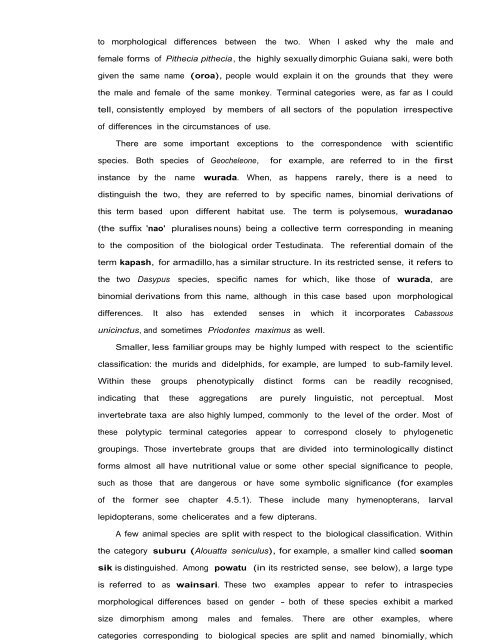Ethnoecology, Resource Use, Conservation And Development In A ...
Ethnoecology, Resource Use, Conservation And Development In A ...
Ethnoecology, Resource Use, Conservation And Development In A ...
Create successful ePaper yourself
Turn your PDF publications into a flip-book with our unique Google optimized e-Paper software.
to morphological differences between the two. When I asked why the male and<br />
female forms of Pithecia pithecia, the highly sexually dimorphic Guiana saki, were both<br />
given the same name (oroa), people would explain it on the grounds that they were<br />
the male and female of the same monkey. Terminal categories were, as far as I could<br />
tell, consistently employed by members of all sectors of the population irrespective<br />
of differences in the circumstances of use.<br />
There are some important exceptions to the correspondence with scientific<br />
species. Both species of Geocheleone, for example, are referred to in the first<br />
instance by the name wurada. When, as happens rarely, there is a need to<br />
distinguish the two, they are referred to by specific names, binomial derivations of<br />
this term based upon different habitat use. The term is polysemous, wuradanao<br />
(the suffix 'nao' pluralises nouns) being a collective term corresponding in meaning<br />
to the composition of the biological order Testudinata. The referential domain of the<br />
term kapash, for armadillo, has a similar structure. <strong>In</strong> its restricted sense, it refers to<br />
the two Dasypus species, specific names for which, like those of wurada, are<br />
binomial derivations from this name, although in this case based upon morphological<br />
differences. It also has extended senses in which it incorporates Cabassous<br />
unicinctus, and sometimes Priodontes maximus as well.<br />
Smaller, less familiar groups may be highly lumped with respect to the scientific<br />
classification: the murids and didelphids, for example, are lumped to sub-family level.<br />
Within these groups phenotypically distinct forms can be readily recognised,<br />
indicating that these aggregations are purely linguistic, not perceptual. Most<br />
invertebrate taxa are also highly lumped, commonly to the level of the order. Most of<br />
these polytypic terminal categories appear to correspond closely to phylogenetic<br />
groupings. Those invertebrate groups that are divided into terminologically distinct<br />
forms almost all have nutritional value or some other special significance to people,<br />
such as those that are dangerous or have some symbolic significance (for examples<br />
of the former see chapter 4.5.1). These include many hymenopterans, larval<br />
lepidopterans, some chelicerates and a few dipterans.<br />
A few animal species are split with respect to the biological classification. Within<br />
the category suburu (Alouatta seniculus), for example, a smaller kind called sooman<br />
sik is distinguished. Among powatu (in its restricted sense, see below), a large type<br />
is referred to as wainsari. These two examples appear to refer to intraspecies<br />
morphological differences based on gender - both of these species exhibit a marked<br />
size dimorphism among males and females. There are other examples, where<br />
categories corresponding to biological species are split and named binomially, which


